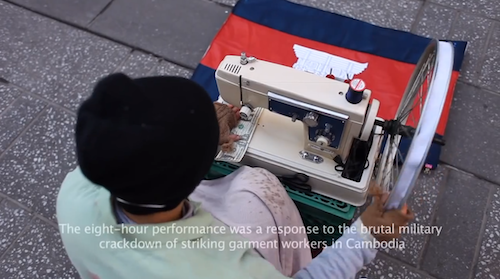How often do we think about where that perfectly snug pair of jeans, or that three-quarter sleeve peasant dress (the one with the fun peacock feather print), originated from?
Who made these clothes? And what are their lives like?
These are questions that we hopefully take the time to ask, and research before buying clothes. Asking ourself: If I buy this, am I supporting a company that treats its workers well? Or, if I buy this am I promoting corporations whom underpay and sometimes, yes, even brutalize their employees in sweatshops?
I never used to ask these questions. I bought mindlessly, never questioning the ethics behind how that Lantern Top I liked, or that navy Shirtdress I loved, came to be.
Shame on me.
Until a few years ago, I never considered the pain and strife that the material brushing up against my skin might have caused someone.
Sweatshops are everywhere.
Companies will always want more for less.
Much of the cheap clothing we buy, in particular, is most likely made in deplorable working conditions. Ask yourself, how can Wal-Mart stay in buisness with its consumers buying a shirt for five dollars, unless that shirt is being made at a much cheaper price? It can’t. Which means? That most likely the people making that shirt get paid next to nothing.
The United States Government is guilty of condoning poor working conditions. It claims to be against overseas sweatshops, yet spends $1.5 billion a year on government clothing in such places as Bangladesh, the Dominican Republic, Haiti, Mexico, Pakistan and Vietnam, at factories that have been proven to promote inhumane working conditions.
Recently, in the capitol of Phnom Penh garment workers protested their inhumane working conditions, demanding a wage of $140 a month opposed to the $95 their government currently offers. Note: The actual living wage in Cambodia is $283, far below even that which the protestors ask.
The Cambodian government responded to this protest with violence. Five protestors were killed and 40 were wounded.
Ninety-percent of the workers currently employed in the 400 garment factories in Cambodia are young women. Which makes me wonder, if ninety-percent were men would the minimum wage still be so atrociously low?
In an article published by The Guardian in December 2013 (highlighting poor working conditions in Cambodia’s garment district) a young woman, Khmom, 19, highlighted how disposable the workers feel, saying, “The factories don’t care about us,” she says. “They pay us so little, work us so hard and throw us away when we cannot work for a moment.”
H & M is one of the retailers whose clothing is produced by these factories.
In response to the recent violence in Phnom Penh, Khmer-American artist Kat Eng sat in front of an H&M in New York City for eight hours, sewing together dollar bills equaling the wage the garment factory workers currently make—less than three dollars a day.
Eng’s performance is called “Less Than Three.”
Watch it here:
The above video contrasts the lives of overworked and underpaid garment workers to those of potential H&M consumers. H&M is just one of the many major retailers whose garments are often produced in this manor. There are many more.
Sitting in front of H&M, with the flashy advertisements behind this performance artist, one can’t help but see the stark difference between where the product originates and where it ends up.
Workers in many of the 400 Cambodian garment factories are disregarded and because they are poor they are unfortunately seen as powerless and expendable. Many people do not think of these workers when they shop at big retail stores, or of the struggle that truly goes into making their clothes.
Eng’s performance art gives voice to this struggle.
And her voice is strong. Here’s what she has to say about the “Less Than Three” project on her website:
“It is an act of solidarity with the women who labor under the boot of multinational corporations and their collapsing industrial machines, women who literally create immense value with their own callused hands yet remain in poverty.
It is a message to consumer culture: behind every stitch is a hand, a face, a person.
It is a critique of working class commodification and the brand industrial complex. I am not here to list the names of every corporation engaged in exploitation in Cambodia—though I will. I am here to meet you, the consumer, and to be consumed by you and to rest in the pit of your stomach. To be explicit, to haunt you while you shop.”
Note: As of today 23 protestors demanding a higher minimum wage have been detained by the Cambodian government. To read more about this, click here.
Also, if interested in following Eng’s project, Upsrei, which aims”…to create rad/feminist media about Khmer struggles, resistance and empowerment,” please click here.
Love elephant and want to go steady?
Sign up for our (curated) daily and weekly newsletters!
Editor: Bryonie Wise
Photo: courtesy of author











Read 0 comments and reply